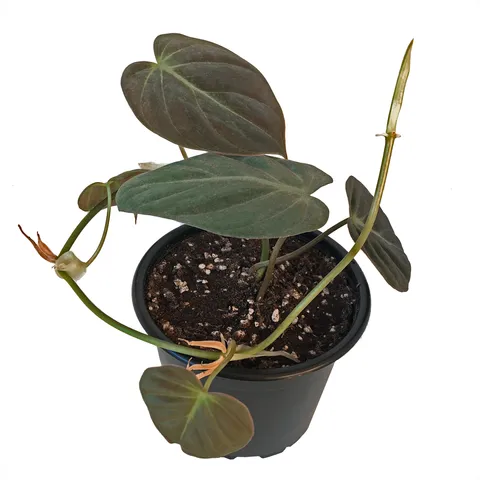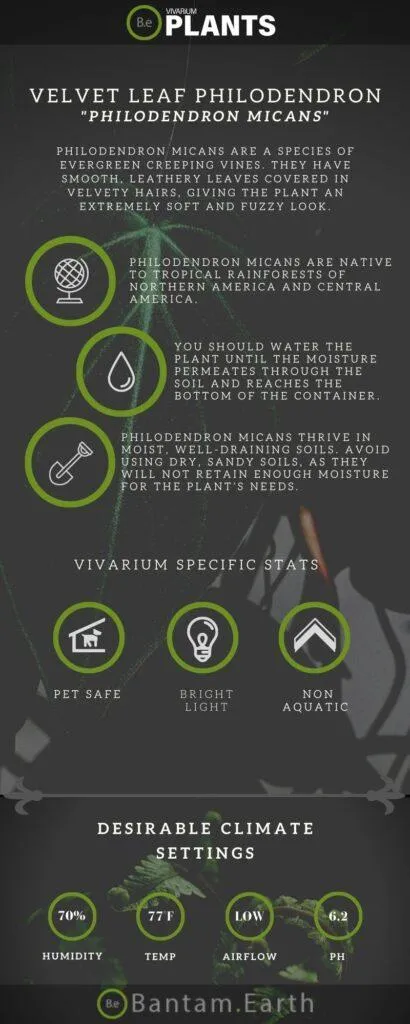Your Comprehensive Guide to the Velvet Leaf Philodendron Plant
If you’ve been searching for information on the velvet leaf philodendron, you’ve come to the right place. As an amateur plant enthusiast, I’ve learned a ton about this fascinating houseplant over the years. In this article, I’ll answer all your questions on care, growing conditions, varieties and more.
What is a Velvet Leaf Philodendron?
To start off basically, the velvet leaf philodendron (Philodendron erubescens) is a climbing vine known for its attractive heart-shaped leaves. As the name suggests, its foliage has a gorgeous velvety or fuzzy texture that sort of feels like shiny suede.
Native to tropical regions of Central and South America, this philodendron thrives as a houseplant in U.S. homes. It’s a super low-maintenance plant – kind of tough to kill, if you know what I mean! From my experience, its resilience and lovely appearance make it a great option for beginner plant parents.
Varieties of Velvet Leaf Philodendron
- Regular velvet leaf philodendron: Has deep emerald leaves with a red underside. This is the most common variety.
- White knight philodendron: Features stunning cream or white variegated leaves edged in green. A little harder to care for but stunning when happy.
- Golden goddess philodendron: Its leaves sport beautiful golden yellow variegation. Needs extra humidity to prevent brown edges.
Thankfully, care requirements are fairly similar across varieties. Let’s dive into what it takes to keep your velvet leaf philodendron looking its best.
Growing Conditions for Velvet Leaf Philodendron
As a houseplant native to tropical climates, the velvet leaf philodendron thrives in warm, humid conditions similar to its natural habitat. Here are the ideal environment specifics:
– Bright, indirect sunlight. Direct sun can scorch its tender leaves. I keep mine near an east-facing window.
– Soil should be well-draining potting mix. I use a homemade recipe of peat moss, perlite and compost.
– Temperatures between 65-80°F are perfect. It may struggle below 60° or above 85°F.
– High humidity between 50-60%. Use a pebble tray or humidifier, especially in winter.
– Water when top inch of soil is dry. Never let it sit in soggy soil.
– Fertilize every 2-4 weeks in spring/summer with a diluted liquid houseplant food.
As long as you mimic these tropical conditions, your philodendron pal should thrive for years! Setting plants on pebble trays filled with water helps increase localized humidity around them.

Caring for Velvet Leaf Philodendron
In my experience, velvet leaf philodendrons are very low maintenance as long as you follow a few basic care tips:
– Water when top inch of soil is dry. Overwatering causes root rot, which is no fun.
– Mist leaves regularly to maintain humidity levels. I give mine a spritz every morning.
– Fertilize monthly during spring and summer using a diluted liquid houseplant food.
– Prune off weakened or bare stems to encourage fresh new growth.
– Repot every 1-2 years in early spring when roots start circling the nursery pot.
– Rotate plant every few weeks so all sides get even sunlight exposure.
– Remove any brown or yellowed leaves as they appear.
See, simple stuff! Once established, my philodendrons can go weeks without watering. Kind of amazing how resilient these tropical beauties are – way easier than real jungles if you ask me!
Propagating Velvet Leaf Philodendron
Another awesome thing about philodendrons is how readily they propagate. You can multiply your plant collection with stem or leaf cuttings using the following method:
- Take 4-6 inch stem cuttings with 2-3 nodes and remove lower leaves. You can also use freshly fallen leaves.
- Place the cutting in a glass of water and change the water every 5-7 days. Roots should form within 4-6 weeks.
- Once a good root system develops, transplant the new plantlet to a 4 inch pot with well-draining soil.
- Mist frequently and keep in indirect light as it grows accustomed to its new home. Soon you’ll have a whole new plant!
I’ve had good success with this low-tech propagation technique. Now you have no excuse not to start your own velvet leaf philodendron collection!
Potential Pests or Diseases
The good news is velvet leaf philodendrons are pretty hardy overall. Here are some minor issues you may encounter though and how to deal with them:
– Mealybugs: Fluffy white insects that suck sap. Wipe leaves with alcohol or use insecticidal soap as needed.
– Spider mites: Tiny red pests that weave webs. Spray leaves with water or pesticide if infestation is severe.
– Underwatering/overwatering: Thirsty or soggy roots cause leaf drop. Adjust watering as described.
– Brown tips: Too low humidity. Use pebble trays, humidifier or mist regularly.
– Rot: Constant wet soil causes yellow leaves and mushy stems. Improve drainage.

With proper care, you hopefully won’t experience major pest or disease problems. Just keep an eye out for any changes and adjust your routine as needed. Communication is key with any relationship!
Using Velvet Leaf Philodendron in Interior Design
These beauties really add life to both indoor and outdoor spaces. You can train them onto poles, trellises or hanging baskets as accent plants, privacy screens, or lush foliage backdrops. Their silvery leaves would look stunning against a grey wall for example.
Velvet leaf philodendron tolerate lower light levels too, making them perfect for living rooms or offices. I’ve seen them creeping up tree trunks in gardens as well. Their dramatic foliage never fails to spark joy and conversation. Who wouldn’t want glimpses of jungle lushness wherever they go?
Just imagine sipping morning coffee beside lacy vines swaying in a sunbeam. Now that’s peace! Philodendrons have such an amazing capacity to elevate a space through their soft, romantic lushness. If you can provide a happy home, any room will thank you for it.
Final Thoughts
In summary, velvet leaf philodendrons make wonderful houseplants for both beginners and experienced gardeners alike. Their glossy foliage and ease of care make them a fantastic addition to any home, indoors or out. With proper growing conditions and routine care, your philodendron friend should reward you with years of natural beauty.
Hopefully this covers all your questions on velvet leaf philodendrons! Let me know if any other aspect needs clarification. Otherwise, happy planting and enjoy your new leafy companion. Their lively presence will surely lighten your day.
“Care Tips for Velvet Leaf Philodendron”
| Fact | Details |
|---|---|
| Light Requirements | Bright, indirect light. Too much direct sun can cause leaf burn. |
| Water | Allow soil to dry out slightly between waterings. Do not overwater. |
| Humidity | Prefers medium to high humidity. Mist leaves regularly if indoor humidity is low. |
| Temperature | Grow best between 65-80°F. May drop leaves if temperature drops below 60°F. |
| Soil | Well-draining, organic potting mix. Heavy clay or soggy soil can cause root rot. |
| Fertilizer | Feed monthly in spring and summer with diluted liquid houseplant fertilizer. |
FAQ
-
What type of plant is a velvet leaf philodendron?
Basically, a velvet leaf philodendron is a tropical houseplant known for its soft, fuzzy leaves. It’s part of the Araceae family.

-
How big do velvet leaf philodendrons get?
These plants can reach anywhere from 3 to 10 feet tall depending on how you grow them. So they get pretty sizeable! At the same time, you can also keep them trimmed smaller if you want.
-
What kind of care do they need?
Velvet philodendrons kinda need the usual things plants require – bright indirect sunlight, consistent watering, and humidity. You’ll want to water whenever the top inch or so of soil dries out. Is that fair? They also do well with occasional liquid fertilizer in the growing season.
-
Are they toxic to pets?
Unfortunately, velvet leaf philodendrons are toxic to cats and dogs if eaten. All parts of the plant – including the leaves – can cause vomiting and diarrhea. So you’ll want to keep it out of reach of any furry friends.
-
Do they need pruning or shaping?
For the most part, velvet leaf philodendrons grow merrily on their own without much maintenance. However, you can do light pruning to encourage bushiness or separate vines. It’s also fun to train the vines onto a moss pole for added visual interest!
-
What kinds of environments do they thrive in?
Basically, these philodendrons are versatile plants that do well in various settings. They can bring lush greenery to your home, office, or bright bathroom. Or if you have a backyard, you might try them as a ground cover or hanging basket outdoors in a spot with partial shade.
-
Do they flower?
While velvet leaf philodendrons are grown primarily for their foliage, they can also produce small, inconspicuous white flowers on mature plants. The flowers don’t last long and aren’t very showy. But it’s kind of cool when your plant decides to bloom, right?
On the other hand, I sometimes poke fun at myself because plants are one of the few things I have a brown thumb with! Maybe it’s just not my green. Does anyone else struggle with keeping houseplants alive? Rhetorical question, I guess. At the end of the day, we all have our strengths and weaknesses – mine just happen to involve a black spot for gardening. But I still love admiring other people’s lush greenery! Citing my grandma’s thumb, she could grow anything from a tomato plant to an avocado tree. I miss her amazing green skills. Quoted for truth!

